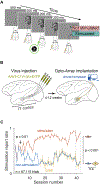Image-dependence of the detectability of optogenetic stimulation in macaque inferotemporal cortex
- PMID: 36610394
- PMCID: PMC9905296
- DOI: 10.1016/j.cub.2022.12.021
Image-dependence of the detectability of optogenetic stimulation in macaque inferotemporal cortex
Abstract
Artificial activation of neurons in early visual areas induces perception of simple visual flashes.1,2 Accordingly, stimulation in high-level visual cortices is expected to induce perception of complex features.3,4 However, results from studies in human patients challenge this expectation. Stimulation rarely induces any detectable visual event, and never a complex one, in human subjects with closed eyes.2 Stimulation of the face-selective cortex in a human patient led to remarkable hallucinations only while the subject was looking at faces.5 In contrast, stimulations of color- and face-selective sites evoke notable hallucinations independent of the object being viewed.6 These anecdotal observations suggest that stimulation of high-level visual cortex can evoke perception of complex visual features, but these effects depend on the availability and content of visual input. In this study, we introduce a novel psychophysical task to systematically investigate characteristics of the perceptual events evoked by optogenetic stimulation of macaque inferior temporal (IT) cortex. We trained macaque monkeys to detect and report optogenetic impulses delivered to their IT cortices7,8,9 while holding fixation on object images. In a series of experiments, we show that detection of cortical stimulation is highly dependent on the choice of images presented to the eyes and it is most difficult when fixating on a blank screen. These findings suggest that optogenetic stimulation of high-level visual cortex results in easily detectable distortions of the concurrent contents of vision.
Keywords: area TE; cortical perturbation; inferior temporal cortex; macaque; optogenetics; perception; vision.
Published by Elsevier Inc.
Conflict of interest statement
Declaration of interests The authors declare no competing interests.
Figures



Comment in
-
Neural coding: Stimulating cortex to alter visual perception.Curr Biol. 2023 Feb 6;33(3):R117-R118. doi: 10.1016/j.cub.2022.12.047. Curr Biol. 2023. PMID: 36750025
References
-
- Gross CG, and De Schonen S (1992). Representation of Visual Stimuli in Inferior Temporal Cortex [and Discussion]. Philos. Trans. R. Soc. Lond. B Biol. Sci 335, 3–10. - PubMed
Publication types
MeSH terms
Grants and funding
LinkOut - more resources
Full Text Sources

